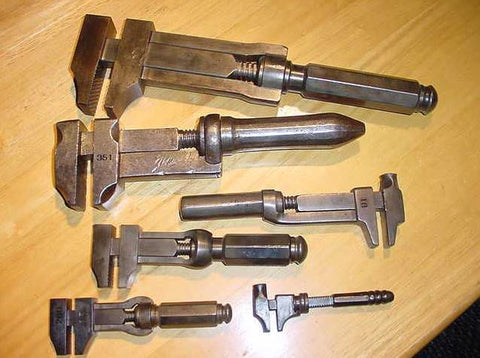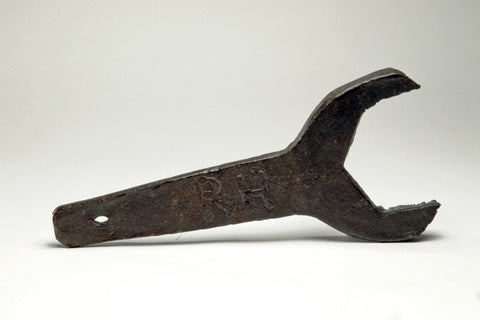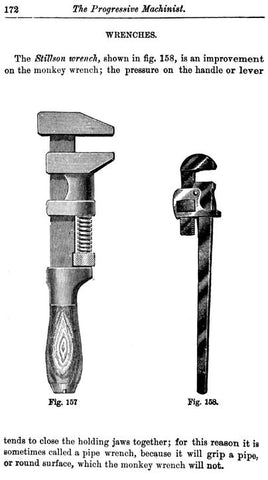History and Origin of Wrenches and Ratchets
Unlike with many other tools, the origin of wrenches, sockets and ratchets are rather well documented and also somewhat recent so there’s a lot of overlap with them all and a lot of improvements and novel designs in a short span of time. All of these tools were invented, or at least patented and put into widespread use, in the 1800s – 1900’s and there are as many similarities as there are differences. It does seem somewhat strange that a hand tool specifically dedicated to manipulate screws, bolts and so on appeared so long after the invention of screw threads, but there was never a need for a separate tool to do this. Threaded screw-like objects first appeared in approximately 400BC and we’ve actually examined some of this history in our blogs about screws and also screwdrivers so refer to those for more information. It’s rumored that screw mechanisms go back further to Roman times as part of door locking mechanisms and it should be noted that threaded screw-like fasteners were used in machines like wine and printing presses as far back as the 15th century. However, rather than being turned by a wrench or a separate tool, these screws in antiquity were loosened and tightened with bars, levers and wheels (which arguably looked cooler) that were often permanent parts of the machine. It wasn’t until the 1800s when machining technology improved to allow screws and bolts small enough for machines to be made and special tools needed to be made to tighten and loosen them.
The oldest of these tools for nuts and bolts is of course the wrench. While there may have been precursors to this tool, and in fact you can see an example of bone tools that act as a primitive wrench for putting leverage on various things, the oldest patented wrench arrived in 1835 and is credited to Solymon Merrick and it appears his design was based in part on English or early coach wrenches some of which date back to 1790-1812. The first wrench of course brought joy to all Three Stooges fans residing in the future. This first wrench had a handle that one could screw up or down to change the size of the aperture to fit the nut or bolt being worked with. This design was definitely an innovation, however other designs cropped up like this 1857 piece by Ezra Ripley which adjusted by moving the handle like a lever. Taft and Mason introduced a wrench similar to Merrick’s in 1857 and another Merrick type popped up in 1858 made by Archibald Murray. Aury Coes of Coes Wrench fame also came up with another lever action adjustable wrench in 1858. By 1870 Daniel Stillson had come up with yet another iconic design of wrench. So a lot of imitation and innovation was all going on simultaneously. There were so many different wrenches patented early on that it’s impossible to go through every one of them.
The year 1858 is also important because it’s often touted as being the first “monkey wrench” coming on the scene and there are many sources that attribute this to a non-existent Charles Moncky or just as falsely to boxer Jack Johnson (who actually did invent this wrench in 1922). The actual story of the monkey wrench is actually an interesting, though convoluted read explaining a possible (non)connection to a Charles Monk as well as use of the phrase in the 1840s in England. It seems to have been in common use in the railroad industry. The article suggests that the monkey wrench has ties to a once popular children’s toy, “monkey on a stick.” It also details the probable origin of the phrase “throw a monkey wrench in the works”. A patent for an actual monkey wrench doesn’t seem to appear until 1897 and looks nothing like the wrench we associate with monkey wrenches. Most if not all Monkey Wrenches appear closer to Merrick’s design and have since evolved as most tools have. To make a long story longer, no one is 100% sure where the monkey wrench came from, but the allusions are that the name was already in use long before the patent was issued and no clear inventor can be named for whatever was in use in the 1840s without more information. What is clear is that the common tales and misconceptions
The standard wrench also received a groundbreaking change with the introduction of a new style of adjustable wrench almost universally referred to as a Crescent wrench due to Crescent Tools introducing it. This was a major innovation as it was compact compared to the larger pipe and monkey wrenches, yet allowed on to adjust its size to work on multiple nuts or bolts. This style of wrench caught on so well that Ford included one with every Model-T and Charles Lindbergh said he’d had one with him on his transatlantic flight. Since then, many other companies have made a version of this style wrench with varying results. While a good tool, there are occasions (especially if using a cheap brand) where the Crescent-style adjustable wrench falls short, namely the thinness of the handle or how finicky the threaded adjustor is and it can be frustrating to use. Thankfully, new designs like Wera’s self-setting spanner still continue to rise up to make life easier. This wrench, part of the Joker family, allows you to get a better grip on the tool and easily adjust the opening to fit the nut or bolt your working all with an easy release.
In addition to the innumerable styles of conventionally-shaped wrenches we also had the invention of the ratcheting wrench bringing huge innovations to the use of sockets. Not long after wrenches were developed, the wrench got a little bit of a run for its money with the introduction of ratchets for use with sockets in 1863. Sockets had been used with hand cranks for centuries, but J.J. Richardson developed the ratchet wrench to be used with interchangeable sockets which has become such a good match it’s almost unthinkable to think of them separately. Sockets were originally square-shaped but as machining techniques improved with technology, hex, Torx and many other shapes became possible. What Richardson’s ratchet wrench brought to the table was groundbreaking in that it allowed the sockets to be removed and more importantly that it allowed a nut to be turned without removing the tool from the nut and allowed for use in restricted space. Some claim that Robert Owen invented the ratchet wrench in 1913, however this is a number of years after Richardson (and even Joseph Reams’ 1907 ratchet wrench) and quite different in that it has two heads – one for each direction. There doesn’t seem to be as much action nor as many stories involved with the ratchet, however innovation has continued until even until today with probably the best designed ratchet -Wera’s Zyklop Ratchet. The Zyklop is loaded with features and has eliminated pretty much every possible headache that comes with using ratchets.
Wrenches, sockets and rackets have helped shape our world in incredible ways since they hit the scene in the late 19th century and even prior to that in their more primitive forms. Wrenches, sockets and ratchets have given us compact, easy to use tools that allow us to get a lot of leverage for tightening and loosening nuts and bolts with minimal effort and in recent years with toolmakers like Wera and others have made it even easier. We’re proud to carry every style of wrench (including many that weren’t mentioned like crowfoot, hook, Knipex’s excellent pliers wrenches, swivel head, strap and socket wrenches), ratchets, and more. You can ensure that whichever of these tools you’re looking for, they’re the best ones available.



























Leave a comment